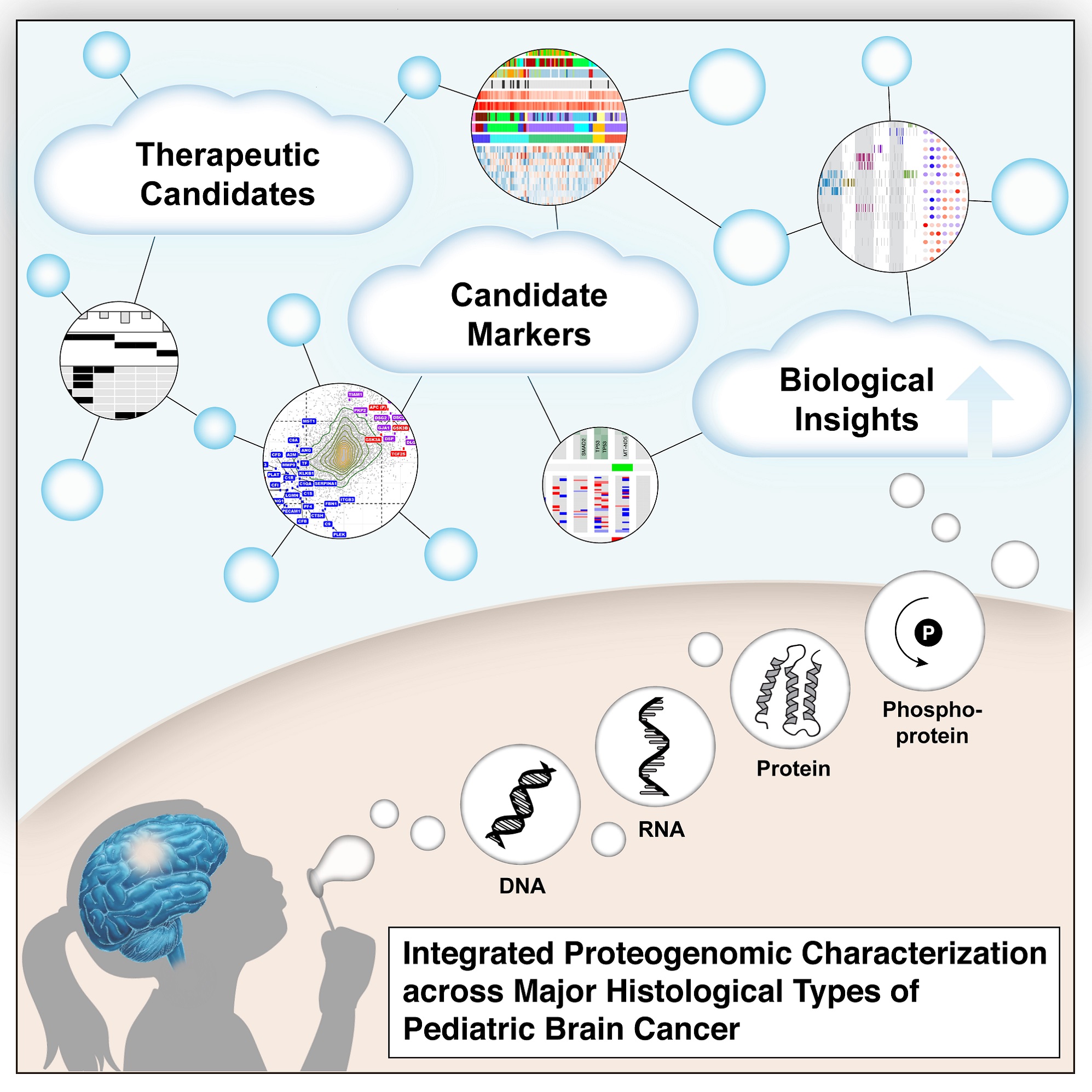A comprehensive “proteogenomic” analysis of the proteins, genes, and RNA transcription involved in pediatric brain tumors has yielded a more complete understanding of these tumors, which are the leading cause of cancer-related deaths in children. The results could help physicians more accurately identify different types of tumors and methods for treating them.
Researchers from the Clinical Proteomic Tumor Analysis Consortium (CPTAC) and Children’s Brain Tumor Network (CBTN) collected and analyzed what’s known as genetic, genomic, and proteomic data from multiple types of brain tumors in children. The consortia consist of collaborators from the Icahn School of Medicine at Mount Sinai, National Cancer Institute, Fred Hutchinson Cancer Research Center, Children’s National Hospital, and Children’s Hospital of Philadelphia. The study, the first large-scale multicenter study focused on pediatric brain tumors, was available online in Cell on November 25.
Clinical Proteomic Tumor Analysis Consortium (CPTAC) and Children’s Brain Tumor Network (CBTN) collected and analyzed what’s known as genetic, genomic, and proteomic data from multiple types of brain tumors in children. The consortia consist of collaborators from the Icahn School of Medicine at Mount Sinai, National Cancer Institute, Fred Hutchinson Cancer Research Center, Children’s National Hospital, and Children’s Hospital of Philadelphia. The study, the first large-scale multicenter study focused on pediatric brain tumors, was available online in Cell on November 25.
“Pediatric cancers in general, and pediatric brain tumors in particular, have a relatively low mutational burden,” explains Pei Wang, PhD, lead corresponding author of the study and Professor of Genetics and Genomic Sciences at the Icahn School of Medicine at Mount Sinai. “Thus, comprehensive characterization of the functional molecular biology of these tumors, including the proteogenomic analysis done in this study, is essential to better understand and treat pediatric brain tumors.”
This study is the first comprehensive survey of genomics (which aims to characterize DNA sequence alterations in a sample), transcriptomics (which aims to quantify copies of RNAs), global proteomics (which aims to identify and quantify proteins), and phosphoproteomics (which quantifies active proteins) across a large cohort of 218 tumor samples representing seven distinct types of brain tumors.
By characterizing biological themes that are shared among these different types of tumors, the study revealed new insights suggesting that current treatments being used for specific tumor types could be applied to others that share the same proteomic features. Specifically, the analyses revealed two distinct subgroups of pediatric craniopharyngioma, a type of pediatric brain tumor. One subgroup showed proteomic/phosphoproteomic characteristics that were strikingly similar to those of another type of tumor, known as “low-grade glioma (LGG) with BRAFV600E mutation.” This observation suggests that MEK/MAPK inhibitors, a type of chemotherapy that has been used against LGG-with-BRAFV600E-mutation tumors, might also help with this subset of pediatric craniopharyngiomas, which currently has no robust chemotherapeutic options.
“The driver of this joint study has been a commitment to data-sharing and open science. Coming together has given both CPTAC and CBTN an opportunity to expand our available resources for answering critically important biological questions. Harnessing the collective expertise across these consortia enables us to better understand the mechanisms of pediatric tumors, improve the process of target protein identification, and potentially improve cancer treatments,” said Adam Resnick, PhD, contributing researcher, Scientific Co-Chair for CBTN, and Director of the Center for Data Driven Discovery in Biomedicine (D3b) at Children’s Hospital of Philadelphia.
By leveraging the rich clinical outcome data of this cohort, the research team also identified new prognostic biomarkers for a type of tumor known as high-grade glioma (HGG). When HGG tumors have a genetic mutation known as a H3K27M mutation, they tend to be very aggressive and the patients have relatively short survival time. However, in those without the mutation, this study suggests that the abundance of proteins named IDH1 and IDH2 in the tumor tissues could help to identify which tumors with the non-mutated H3K27M gene may be less aggressive.
“Integration of the clinical, proteomic, and genetic data generated in this study allows us to construct a more comprehensive model of brain tumor biology, which will lead to more targeted treatments,” said Brian Rood, MD, contributing researcher, Executive Co-Chair for CBTN, and Medical Director of the Brain Tumor Institute at Children’s National Hospital.
The data analysis also showed key biological differences in samples from primary and recurrent tumors from the same patients, indicating the need for independent assessment and therapeutic decisions for these tumors.
“The current study is the first to reveal in pediatric brain tumors the power of proteins to better determine which patient might benefit from a given therapy, and our validation studies using targeted proteomics provide a platform for clinical implementation of the findings” said co-author Amanda Paulovich, MD, PhD, Aven Foundation Endowed Chair and professor in the Clinical Research Division at Fred Hutchinson Cancer Research Center. “As this work moves further along toward clinical validation, I hope it brings comfort to patients and their families who have suffered from this terrible disease.”
Publication: Petralia, Francesca, et al. for the Clinical Proteomic Tumor Analysis Consortium. Integrated Proteogenomic Characterization across Major Histological Types of Pediatric Brain Cancer. Cell. Nov. 25, 2020.

